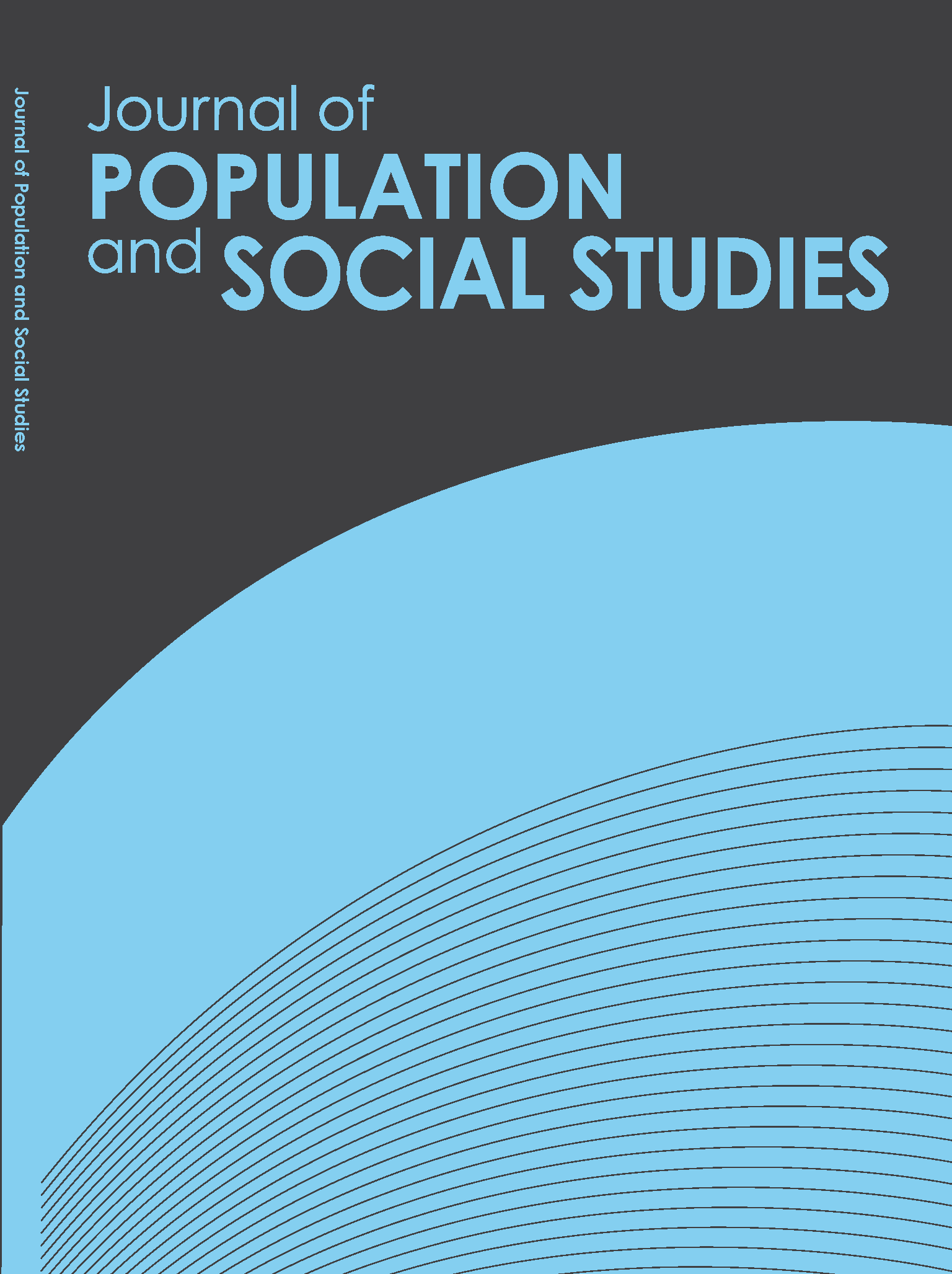Smart Devices and Family Roles: A Study of Smart Device Use Among Children Aged 2-5 in Thailand’s Health Region 3
Main Article Content
Abstract
This research investigated smart device use among young Thai children. The study likewise explored the relationship between smart device screen time, family roles in smart device use, and effects of smart device use. In 2020, primary data were collected through questionnaires from 1,100 primary parents of 2-5-year-old children in five provinces in Health Region 3. A Mann-Whitney U Test and Median Test were used in data analyses of the associations. The results revealed that 2-5-year-old children had an average screen time per day of 1 hour and 33 minutes, with 54.3% spending more than 1 hour on smart devices daily. In addition, 21.5% reported owning a smartphone, of which 55.2% accessed YouTube to watch cartoons and movies. In terms of screen time, 21.7% of the children reported unrestricted use. In terms of effects from smart device use, children being easily irritated and moody was noted by most parents (61.5%). In addition, variables under family roles and effects of smart device use showed a statistically significant correlation with smart device screen time. However, median screen time varied by each variable under family roles and effects of smart device use. The findings are essential for future policy planning, which will enable families with young children to become aware of appropriate smartphone or tablet usage by their children.
Article Details
References
• Bozzola, E., Spina, G., Ruggiero, M., Memo, L., Agostiniani, R., Bozzola, M., Corsello, G., &Villani, A. (2018). Media devices in pre-school children: The recommendations of the Italian pediatric society. Italian Journal of Pediatrics, 44, 69. https://doi.org/10.1186/s13052-018-0508-7
• Department of Pediatrics, Faculty of Medicine at Siriraj Hospital in Thailand. (2015). เลี้ยงลูกด้วยแท็บเล็ตสมาร์ทโฟนดีจริงหรือ [Is it good to raise kids with smartphones and tablets?]. https://www.si.mahidol.ac.th/siriraj_online/thai_version/Health_detail.asp?id=1188
• Chaudron, S. (2015). Young children (0-8) and digital technology: A qualitative exploratory study across seven countries (EUR27052). Publications Office of the European Union. http://dx.doi.org/10.2788/00749
• Hosokawa, R., & Katsura, T. (2018). Association between mobile technology use and child adjustment in early elementary school age. PLoS ONE, 13(7), e0199959. https://doi.org/10.1371/journal.pone.0199959
• Institute of Medicine and National Research Council. (2015). Transforming the workforce for children birth through age 8: A unifying foundation. The National Academies Press. https://doi.org/10.17226/19401
• Kabali, H. K., Irigoyen, M. M., Nunez-Davis, R., Budacki, J. G., Mohanty, S. H., Leister, K. P., & Bonner, R. L. (2015). Exposure and use of mobile media devices by young children. Pediatrics, 136(6), 1044-1050. https://doi.org/10.1542/peds.2015-2151
• LeBourgeois, M. K., Hale, L., Chang, A. M., Akacem, L. D., Montgomery-Downs, H. E., & Buxton, O. M. (2017). Digital media and sleep in childhood and adolescence. Pediatrics, 140(Suppl 2), S92-S96. https://doi.org/10.1542/peds.2016-1758J
• Madigan, S., Browne, D., Racine, N., Mori, C., & Tough, S. (2019). Association between screen time and children’s performance on a developmental screening test. JAMA Pediatrics, 173(3), 244-250. https://doi.org/10.1001/jamapediatrics.2018.5056
• Manas, G. M. (2020). Study on childhood development in early stage. Scholarly Research Journal for Interdisciplinary Studies, 7(59), 13927-13938. https://www.srjis.com/pages/pdfFiles/159531456910.%20harvinder%20kaur(OK)%20(2).pdf
• McChesney, K. Y., & Bengtson, V. L. (1988). Solidarity, integration, and cohesion in families: Concepts and theories. In D. J. Mangen, V. L. Bengtson, & P. H. Landry, Jr. (Eds.), Measurement of intergenerational relations (pp. 15–30). Sage Publications, Inc.
• Ministry of Public Health. (2016a). คู่มือการพัฒนาเด็กปฐมวัย (อายุต่ำกว่า 5 ปี) สำหรับผู้ปกครอง [Handbook of early childhood (under 5 years of age) development for parents]. http://www.thaichilddevelopment.com/images/doc/Ebook1.pdf.
• Ministry of Public Health. (2016b). เฝ้าระวังและส่งเสริมพัฒนาการเด็กปฐมวัย [Developmental Surveillance and Promotion Manual]. https://apps.hpc.go.th/dl/web/upFile/2020/02-4052-20200220175136/297d40a3eef9ae0253e5bb14f8e4caf4.pdf
• National Statistical Office. (2016). Thailand Multiple Indicator Cluster Survey 2015-2016.National Statistical Office. http://www.nso.go.th/sites/2014en/Survey/social/domographic/MICS/Thailand_MICS_Full_Report_EN.pdf
• Rajanagarindra Institute of Child Development. (2016). คู่มือคัดกรองและส่งเสริมพัฒนาการเด็กวัยแรกเกิด-5 ปี: สำหรับบุคลากรสารธารณสุข [Thai Development Skills Inventory for Children from Birth to Five Years (TDSI) for Healthcare Personnel]. Rajanagarindra Institute of Child Development. https://www.thaichilddevelopment.com/images/doc/roporsortor70.pdf
• Tamana, S. K., Ezeugwu, V., Chikuma, J., Lefebvre, D. L., Azad, M. B., Moraes, T. J., Subbarao, P., Becker, A. B., Turvey, S. E., Sears, M. R., Dick, B. D., Carson, V., Rasmussen, C., CHILD study investigators, & Pei, J. (2019). Screen-time is associated with inattention problems in preschoolers: Results from the CHILD birth cohort study. PLoS ONE, 14(4), e0213995. https://doi.org/10.1371/journal.pone.0213995
• van den Heuvel, M., Ma, J., Borkhoff, C. M., Koroshegyi, C., Dai, D. W. H., Parkin, P. C., Maguire, J. L., & Birken, C. S. (2019). Mobile media device use is associated with expressive language delay in 18-month-old children. Journal of Developmental and Behavioral Pediatrics, 40(2), 99–104. https://dx.doi.org/10.1097%2FDBP.0000000000000630
• World Health Organization. (2019). Guidelines on physical activity, sedentary behaviour and sleep for children under 5 years of age. World Health Organization. https://apps.who.int/iris/handle/10665/311664


